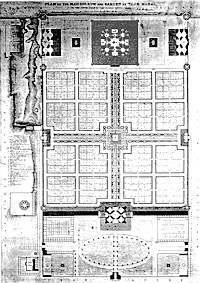|
The range of fountains that can be created today is vast. In this chapter we look at the principle sources of style of fountain, in what must be a very potted history. Most classical fountains can find their roots in one or more of the gardening styles that follow: 1. The Persian Garden developed in the mountainous plateau which formed the central area of the Persian Empire. There water was a priceless commodity. This was reflected in the traditional Persian Garden which was composed of four essentials: water for irrigation, display and sound, shade trees for shelter, flowers for scent and colour, and music to delight the ears, a typical garden design found from Persia to Spain and in many old carpets and miniture paintings is a quadrant pattern with water channels dividing the garden into four sections (Figure 6).
The Persian Influence is reflected after the Arabs overran the Persian Empire, Traditionally nomads, the Arabs, who were kept on on the move by the constant search for water in the Arabian deserts, journying from one oasis to another. They did not have the integrated and advanced culture that the Persians had developed with their long established settlements. The Arabs developed the Persian style of garden in two principly different ways, namely the Mughul style, best illustrated in the Vale of Kashmere and the Moorish style for which the works at Granada are the most famous.
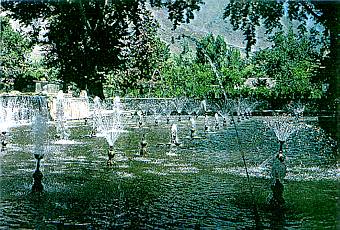 Figure 7. The Gardens at Shalamar Baghin. Kashmir.
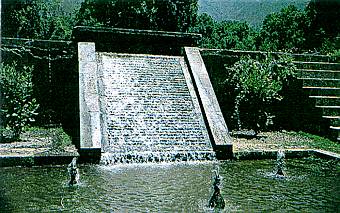 Figure 8. A Chadar.
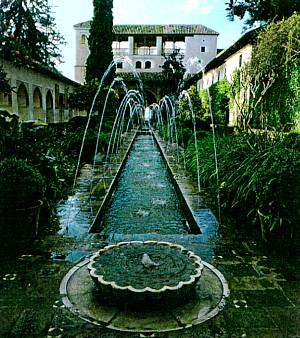 Figure 9. The Court of the Canal. Genalalife. Granada. It is not difficult either to understand the nomadic Arabs retaining a high respect for water as a valued resource. This was combined with a cultural approach similar to that of China and Japan, by which gardens were designed as places for private meditation and luxury rather than for public sharing as with the Greek and Roman civilizations. Two great qualities stand out in Islamic gardens and fountains. Firstly the fountains never had any likeness of men, as the Koran forbade it, and secondly they were always more restrained in the quantity of water used (excepting certain Mughal gardens) although this was balanced with a feeling of plenty. They combined the need for irrigation with channels bowls and fountains to create cool, sweet smelling gardens in the hottest and most hostile of terrain. The bubble fountain in which the fountain barely disturbs the surface of the water is a good example of that respectful restraint. Basins were designed to be continually full to the brim with water overflowing to secondary channels. The basins were often faceted or carved in a lotus pattern, which makes a small volume of water seem greater. Islamic fountain basins were invariably mounted close to the ground, often barely extending above the surface of the surrounding plane. They are thought to have served the function of cooling the courts in which they were placed through evaporation, in addition to their religious functions. (Figure 10.) 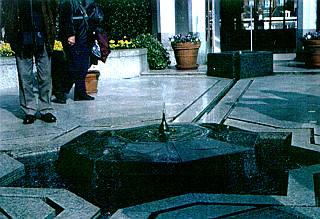 Figure 10. Fountain at the Ismali Centre. London. Moorish design made the most use of water in other ways too, channelling it carefully for use in irrigation when its display functions were fulfilled. This quality was singularly lacking in renaissance and post renaissance Italy where man made profligate use of gravity fed water from the hills. 2. The Western garden. Has its roots in Greece and Ancient Rome. With the coming of the renaissance to Italy, and Rome in particular, the water garden developed, using the plentiful water supply of the hills combined with basic piping and gravity. It was only with the development of the water powered pump that the styles evolved in the Roman hills were able to be used in the gravity fed fountains. Thereafter the styles of water gardens of Rome and Italy were able to spread to greater Europe where they were adapted by the French to reach a formal zenith at Versailles. An outstanding example of an Italian post renaissance garden is at the Villa Lante at Bagnaio which was built about 1566 by the architect Vignola for a Cardinal Gambara. (Figure 11.) 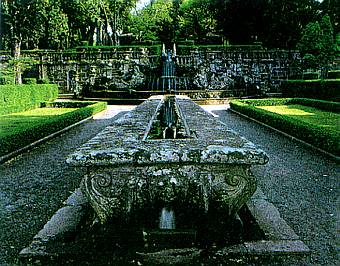 Figure 11. Water Table at Villa Lante. Bagnaio. Jellicoe considers that perfection in the Renaissance style garden was reached. "The whole design of the garden is etched in water. From the rock face at the top a little waterfall fills a rough stone pool. the water is then led down the centre of the garden in stages each more sophisticated than the last until it reaches the water-parterre at the bottom. The entrance to the garden is at this level and is reached by steps which pass above a large curved pool with sculpture by Giambologna in the centre. This pool has a crucial function since it links the formal garden with its counter-balance, the half-wild woodland threaded with paths and occasional fountain jets." In particular the development of the cascade, or downward falling fountain is seen to have flourished in the gravity fed renaissance gardens of Italy. In Rome fountains with statuary and abundant water abound as a consequence of the reinstatement of the earlier water supply systems. The Trevi Fountain (Figure 12.) is a fine example of a Roman display fountain, and until recently it flowed with potable water. It is probably the world's best known fountain. It was built as the Mostre, or show piece, of the Acqua Vergine Antica water system, which was the first to be rebuild by Nicholas V., about 1453, after the dark ages. 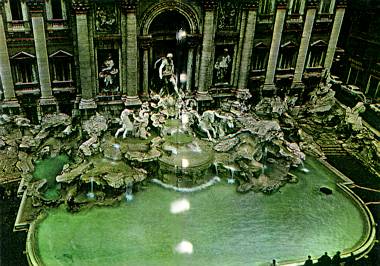 Figure 12. The Trevi Fountain. Rome. The first Trevi fountain was a plain wall fountain designed by Leone Gattista Alberti, at that time. In 1640 Pope Urban VIII asked Giobanni Bernini to design a new fountain, but Bernini died before his plans were complete. Delay followed delay and it was 122 years later that the fountain was completed to a design by Nicola Salvi. In May 1762. The result was "an imperial gesture, flamboyant and triumphant, the kind of fountain that any Emperor would have erected who desired to impress upon the populace the virtues of new water and his own virtue in introducing it" "Much of the most beautiful dream architecture of the seventeenth and eighteenth centuries went up in flames in the course of firework displays and the greatest architects of the time were willing to design the ephemeral scenery of masques and public spectacles. Consequentially the Trevi is probably that rare object, a reflection in stone of those fragile splendours. That Neptune should suddenly appear, escorted by Tritons and sea-horses and accompanied by a great waterfall, upon the placid facade of an Italian palace, a display of primitive energy as violent and unexpected as a burst water main in Piccadilly, is typical of the 17 century masque." Following the advent of water powered pumps, France led the way with new and grand water features. At Verseilles, for example, water gardens were commissioned by Louis XIV and designed by the vastly influential director of Royal gardens, Andre Le Notre, who completed them in 1668. This French style of garden eventually dominated Europe, although perceptibly altered in some ways by each of the countries that it influenced. Most classical fountains has evolved from this route, as can be seen at Witley court and countless other examples in this country. 3. The Oriental garden. It is in the recreation and exploitation of natural effects with water that the Chinese and Japanese water gardens excelled, In fact they took it to such a pitch that they reproduced the effect of downward flowing water using sand and rocks. The philosophy of oriental gardens evolved around the creation of places of solitude and contemplation, working with, rather than overcoming and taming nature, and it is only in this context that it is relevant to fountains. It has been argued that the English Landscape gardening of the 18th. century, as practiced by Capability Brown, Humphrey Repton and the like, was taken from the oriental style of gardening. It was seen, unlike the European renaissance movement, to present a more naturalistic, stylized form of gardening. The oriental style, precursor of the English Landscape movement, rarely used rising jet fountains and when using fountains at all relied mainly on natural water flows through dams as the natural overflows to lakes and informal pools. NEXT: POWER AND PUMPS
|

http://www.gardening-uk.com/waterlands/
email: b.hirst@mac.com
